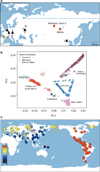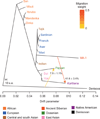Upper Palaeolithic Siberian genome reveals dual ancestry of Native Americans
- PMID: 24256729
- PMCID: PMC4105016
- DOI: 10.1038/nature12736
Upper Palaeolithic Siberian genome reveals dual ancestry of Native Americans
Abstract
The origins of the First Americans remain contentious. Although Native Americans seem to be genetically most closely related to east Asians, there is no consensus with regard to which specific Old World populations they are closest to. Here we sequence the draft genome of an approximately 24,000-year-old individual (MA-1), from Mal'ta in south-central Siberia, to an average depth of 1×. To our knowledge this is the oldest anatomically modern human genome reported to date. The MA-1 mitochondrial genome belongs to haplogroup U, which has also been found at high frequency among Upper Palaeolithic and Mesolithic European hunter-gatherers, and the Y chromosome of MA-1 is basal to modern-day western Eurasians and near the root of most Native American lineages. Similarly, we find autosomal evidence that MA-1 is basal to modern-day western Eurasians and genetically closely related to modern-day Native Americans, with no close affinity to east Asians. This suggests that populations related to contemporary western Eurasians had a more north-easterly distribution 24,000 years ago than commonly thought. Furthermore, we estimate that 14 to 38% of Native American ancestry may originate through gene flow from this ancient population. This is likely to have occurred after the divergence of Native American ancestors from east Asian ancestors, but before the diversification of Native American populations in the New World. Gene flow from the MA-1 lineage into Native American ancestors could explain why several crania from the First Americans have been reported as bearing morphological characteristics that do not resemble those of east Asians. Sequencing of another south-central Siberian, Afontova Gora-2 dating to approximately 17,000 years ago, revealed similar autosomal genetic signatures as MA-1, suggesting that the region was continuously occupied by humans throughout the Last Glacial Maximum. Our findings reveal that western Eurasian genetic signatures in modern-day Native Americans derive not only from post-Columbian admixture, as commonly thought, but also from a mixed ancestry of the First Americans.
Figures



References
-
- Turner CG. Advances in the dental search for native american origins. Acta Anthropogenet. 1984;8:23–78. - PubMed
-
- Hubbe M, Harvati K, Neves W. Paleoamerican morphology in the context of European and East Asian Pleistocene variation: implications for human dispersion into the New World. Am. J. Phys. Anthropol. 2011;144:442–453. - PubMed
-
- Schurr T. The peopling of the New World: perspectives from molecular anthropology. Annu. Rev. Anthropol. 2004;33:551–583.
-
- O’Rourke DH, Raff JA. The human genetic history of the Americas: the final frontier. Curr. Bio. 2010;20:R202–R207. - PubMed
Publication types
MeSH terms
Substances
Associated data
- Actions
- SRA/SRP029640
Grants and funding
LinkOut - more resources
Full Text Sources
Other Literature Sources
Molecular Biology Databases
Research Materials

